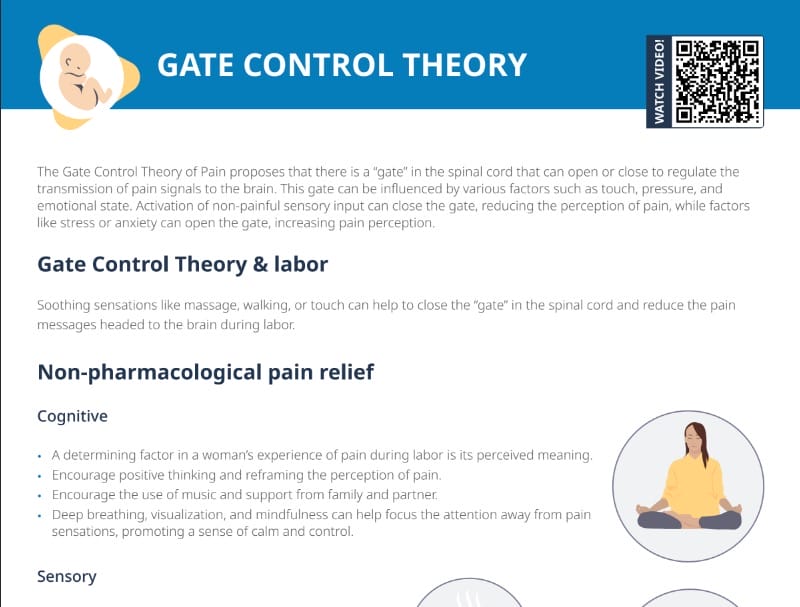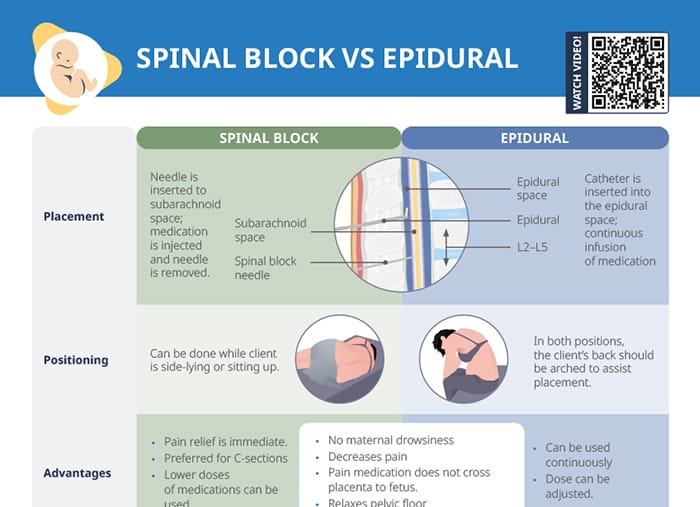What is an epidural?
Epidurals are an anesthesia technique where medication is injected into the epidural space around the spinal cord to provide pain relief or numbness.
When was the epidural invented?
The epidural technique was developed in 1921.
How long does an epidural last?
The pain relief with an epidural can take 10–15 minutes after initiation. It does not have a set duration but can be used continuously, with the dose being adjusted as needed.
Epidural placement
For an epidural, a catheter is inserted into the epidural space for the continuous administration of medication. The client’s back should be arched to assist placement.
What is a spinal block?
A spinal block is a type of anesthesia where medication is injected directly into the cerebrospinal fluid in the subarachnoid space, causing immediate and significant numbness.
A spinal block is the preferred method during C-sections and has the advantage that lower doses of medications can be used.
How long does a spinal block last?
While the pain relief after a spinal block is immediate, the effect only lasts for 1 to 3 hours.
Spinal block placement
The needle is inserted into the subarachnoid space to inject the medication. This can be done with the client side-lying or sitting up.
Spinal block vs epidural: similarities and differences
Disadvantages of both methods
Risks and downsides include:
- Hypotension
- Nausea
- Maternal hyperthermia
- Spinal HA
- Risk of high spinal respiratory paralysis
- Allergic reactions
- Bladder paresthesia
- Limited mobility
Main differences
| Spinal block | Epidural |
| Immediate onset | Gradual onset |
| Injected into subarachnoid space | Catheter placed in epidural space |
| Used for shorter procedures, C-section | Suitable for long procedures or labor, can be adjusted over time |
Related videos
Nursing interventions and client education
Nursing interventions for spinal block and epidural
- Physical assessment
- Sign consents
- Prepare client physically and mentally
- Hydration
- Position client
- Vital signs
- Fetal heart rate monitoring
- Bladder monitoring
Be aware of your unit’s NPO policy prior to scheduled C-sections. Educate clients on safe positioning to facilitate labor progress.
Common client questions
- How big is the epidural needle? 16 to 18 gauge in diameter, about 3.5 to 5 inches in length
- How much does an epidural cost? $1,000 to $2,500 without insurance coverage
- When is it too late to get an epidural? The decision is up to providers, but advanced labor, rapid labor progression, or imminent delivery can be factors.
- How long after getting an epidural does the baby come? The epidural does not influence labor duration, so this question cannot be answered generally.
- Why is pain worse after an epidural steroid injection? Pressure from the injection fluid or irritation of nerves can temporarily worsen pain.
- How long after an epidural can you walk? Most clients can walk within 2–4 hours after the epidural has stopped, but this can be individual.
- What not to take before epidural injection: blood thinners, NSAIDs, certain herbal supplements

